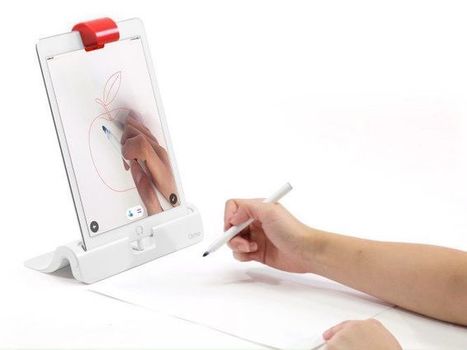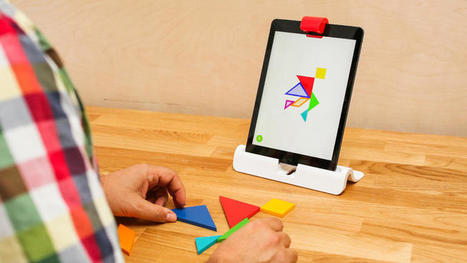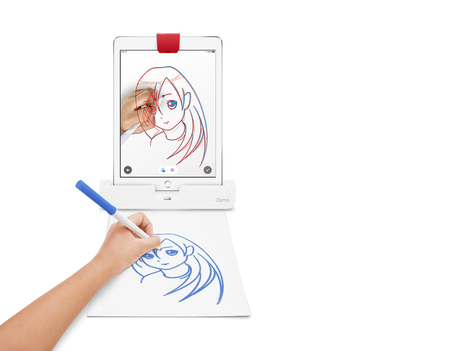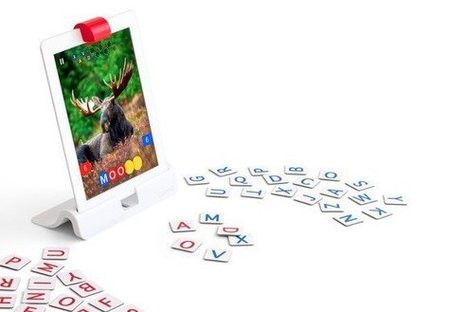 Your new post is loading...
 Your new post is loading...
More than 30,000 schools use Osmo. Click to see our lesson plans, teacher’s guide, and more.
Since the time of Cuisenaire rods or before that counters and buttons
students have benefitted from the use of concrete materials in their
mathematical learning. The combination of strong visuals and the ability to
physically manipulate groups of objects has allowed students to move from
purely physical representations of number concepts to increasingly abstract
representations. This pattern of first experiencing a concept in the
physical world before shifting towards symbolic representations has allowed
countless students to grasp the fundamentals of mathematics. Effective
teachers have always been able to maximise the benefits of this pattern
ensuring that their students can not only produce the right answer but have
a solid understanding of the mathematics behind it.
In the age of computers and now tablets there have been many efforts to
transfer this effective learning pattern into the digital world.
Skeuomorphic representations that take digital renderings of real world
objects and place them onto screens for manipulation through the computer
interface have had some success in this area but an additional layer of
abstraction is added that purely physical manipulations lack. Shifting the
physical objects into the digital world may bring new affordances to the
devices used but fail to transform the learning that was already possible
with concrete materials. What was needed was a relationship between the
digital and the physical that would enhance the quality of learning
possible. With new tools such as easily coded robots, augmented reality and
3D printing this is a possibility that is beginning to emerge.
One interesting option is the iPad system and related Apps made available
by ‘Osmo’. In this the camera on the iPad is reconfigured to capture images
from the area immediately in front of the device as it sits in a stand. The
software allows for virtual objects on the iPad screen to appear to
interact with objects placed or drawn in front of it. One of the Apps
available presents the challenge of manipulating the trajectory of a
virtual ball using objects placed or drawn in the real world space in front
of the device. Students learn through an iterative process of altering
angles of incidence and by adding or removing objects how the trajectory of
an object can be altered. The software allows for complex interactions to
be simulated and tested with immediate feedback provided on the screen.
Other Apps allow students to manipulate Tangrams with added benefits
occurring as a result of the augmented reality. Another App bridges the gap
between the physical and the abstract by allowing students to manipulate
real objects while the device reveals the associated abstract
representations. Osmo brings an added dimension compared to purely digital
Apps that attempt to do the same thing as its physical dimension invites
collaboration. Students will want to sit and play with the physical objects
and though the manipulations of these experience gradually increasing
levels of engagement with symbolic representations.
Learn more about Osmo
Sphero is another interesting way to take mathematics out of the digital
world and allow it to blend with the physical. Sphero is a small spherical
robot that can be controlled directly using a phone or tablet, can be
programmed or can be used as a controller or interactive object with
augmented reality games. Beyond the fun that comes from using Sphero like a
remote controlled toy is the potential to use it to explore concepts within
mathematics. This process is likely to begin with lessons that require
students to programme their Sphero to complete a maze. Constructed on the
floor with tape, cardboard or with a mixture of made and found obstacles
mazes allow students to explore aspects of measurement of length, area,
angles, time and speed. Unlike purely digital solutions that target these
concepts Sphero brings a real connection between the code and the movement
of the robot. Students engaging with Sphero will take measurements in the
real world with traditional tools such as metre rules and protractors
(preferably oversized ones), use that information in the digital code
environment and then make adjustments based on the path taken by the robot.
Again success is supported through an iterative approach with immediate and
natural feedback. These feedback loops where the students are quickly shown
what works and what does not are judgment free and ensure continued
engagement with the problem and with each failed attempt revealing
something new about the task while allowing the students to laugh at their
robots misadventures. That students are learning to code while they are
developing their understanding of mathematical concepts is further bonus.
Beyond the maze activities are options for an exploration of how the robot
may be programmed to complete artistic pieces that combine its movement and
ability to change colours into robotic ballets that could include
collaborations with other robots.
Learn more about SPHERO
You can’t mention links between digital worlds and physical reality without
mentioning 3D printing. For explorations in STEAM the increasingly
affordable 3D printer brings the opportunity to design objects in a
physical world and then print a real model that the students can hold. So
many mathematical concepts from mass, volume, capacity, scale, ratio, and
3D shape can be explored in this way and links across key learning areas
can be readily explored. For design thinking tasks the potential to have a
physical prototype of an idea brings a tangible dimension that reveals
ideas in new ways showing how imaginings in the virtual world translate
into the real world. Increased accuracy of 3D printers is allowing for
objects with great precision which means it is possible to print parts of
machines with moving and interlocking cogs. Software is available now that
will show how these moving parts will interact in a virtual world thus
enabling testing of designs in this space prior to printing.
In each case here there is a linking of learning in a digital space with
the manipulation of creation of real world objects. instead of moving
further away from the use of concrete objects blended environments suggest
that mathematics teaching may be most successful when a mix of digital and
physical is enabled. It may not be time to throw away those Cuisenaire rods
and oversized set squares just yet, they may have a new part to play in the
emerging terrain of mathematical learning.
By Nigel Coutts
Today the field of educational technology is literally bombarded with new ideas and devices that promise to revolutionize the way we teach. Some of these newcomers have strong potential and promise a unique learning experience. One such product is Osmo. Osmo is an innovative device that transforms an iPad into an interactive classroom accessory able […]
Like digital tracing paper, the new Masterpiece app for Osmo's iPad accessory lets you draw with pens and pencils while using the screen as a guide.
|
Get the most out of your Osmo
Osmo | Educational Games System for iPad. Draw, spell, create and more. When you buy 1, they donate 1 to a classroom of your choice!
|
 Your new post is loading...
Your new post is loading...
 Your new post is loading...
Your new post is loading...

















